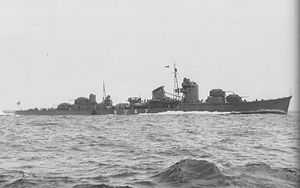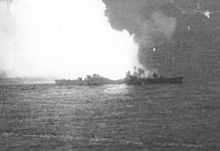Japanese destroyer Akizuki
 Akizuki on trial run off Miyazu Bay on May 17, 1942. | |
| Career | |
|---|---|
| Name: | Akizuki |
| Builder: | Maizuru Naval Arsenal |
| Laid down: | 30 July 1940 |
| Launched: | 2 July 1941 |
| Completed: | 11 June 1942 |
| Commissioned: | 11 June 1942, Yokosuka Chinjufu |
| Struck: | 10 December 1944 |
| Fate: | Sunk in action 25 October 1944 |
| General characteristics | |
| Class and type: | Akizuki-class destroyer |
| Displacement: | 2,700 long tons (2,743 t) standard 3,700 long tons (3,759 t) full load |
| Length: | 134.2 m (440 ft 3 in) |
| Beam: | 11.6 m (38 ft 1 in) |
| Draft: | 4.15 m (13 ft 7 in) |
| Propulsion: | 4 × Kampon type boilers 2 × Parsons geared turbines 2 × shafts, 50,000 shp (37 MW) |
| Speed: | 33 knots (38 mph; 61 km/h) |
| Range: | 8,300 nmi (15,400 km) at 18 kn (21 mph; 33 km/h) |
| Complement: | 263 |
| Armament: | June 1942 : • 8 × 100 mm (4 in)/65 cal Type 98 DP guns • 4 × 25 mm AA guns • 4 × 610 mm (24 in) torpedo tubes • 8 × Type 93 torpedoes • 56 × Type 95 depth charges October 1944 : • 8 × 100 mm (4 in)/65 cal DP guns • 35 × 25 mm AA guns • 4 × 13 mm AA guns • 4 × 610 mm (24 in) torpedo tubes • 8 × Type 93 torpedoes • 56 × Type 95 depth charges |
Akizuki (秋月) was the lead ship of her class of destroyer in the Imperial Japanese Navy. Her name means “Autumn Moon.”
In October 1944 Akizuki was part of the Northern Force commanded by Vice Admiral Ozawa Jisaburo, in the Japanese attack on the Allied forces supporting the invasion of Leyte. On 25 October, in the Battle off Cape Engaño, it was sunk, probably by torpedo, ENE of Cape Engaño (20°29′N 126°30′E / 20.483°N 126.500°ECoordinates: 20°29′N 126°30′E / 20.483°N 126.500°E), during the initial U.S. air attack on the Northern Force. Most sources credit the hit to aircraft of Task Force 38, but some give credit to submarine USS Halibut (SS-232).
See also
References
- Jentschura, Hansgeorg; Jung, Dieter; Mickel, Peter (1977). Warships of the Imperial Japanese Navy, 1869-1945. Annapolis: United States Naval Institute. ISBN 0-87021-893-X.
- Nevitt, Allyn D. (1998). "IJN Akizuki: Tabular Record of Movement" (WEB PAGE). CombinedFleet.com. Retrieved 2 January 2009.
- Watts, Anthony J. (1971). The Imperial Japanese Navy. Doubleday. ISBN 0-385-01268-3.
External links

Akizuki blows-up during battle of Cape Engano
| ||||||||||||||||||||||||||||||||||||||||||||